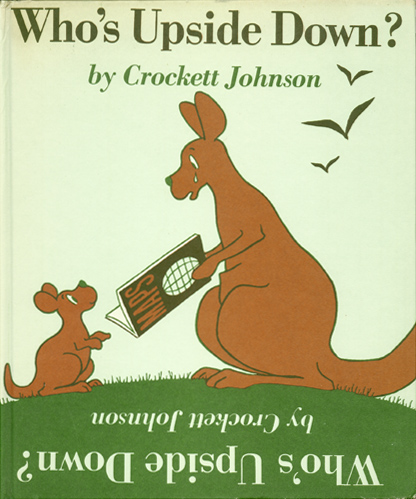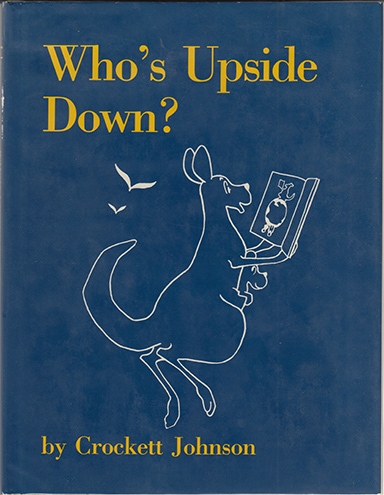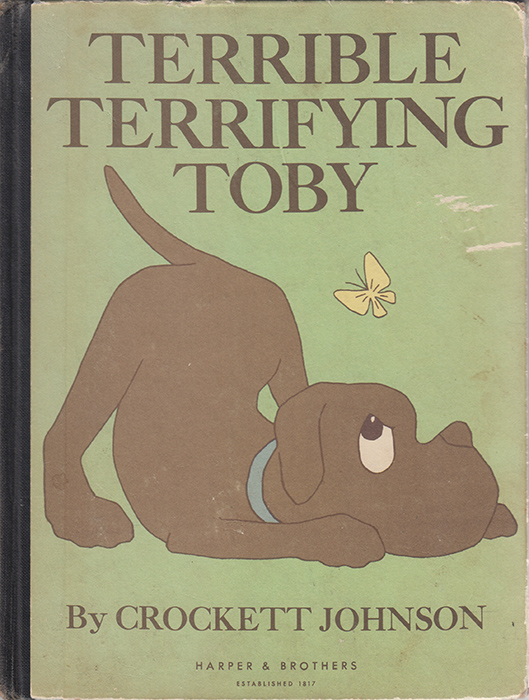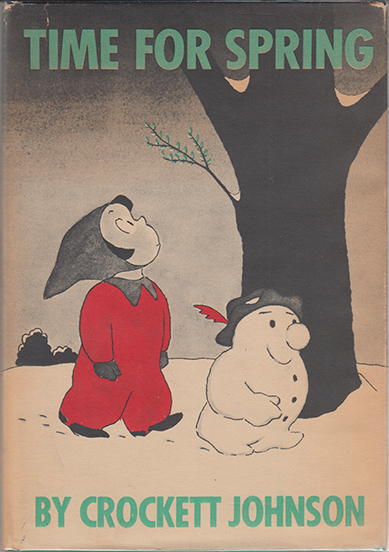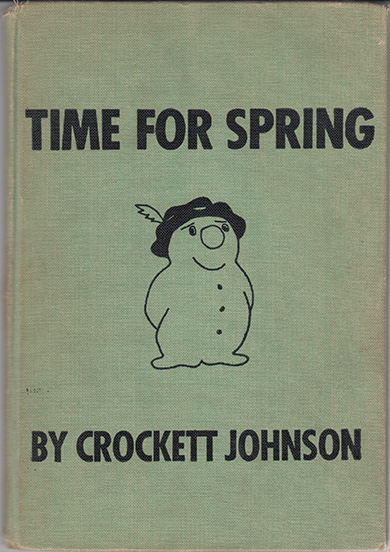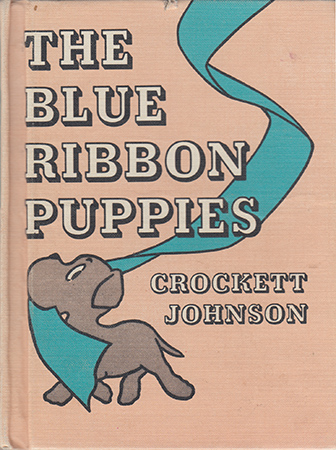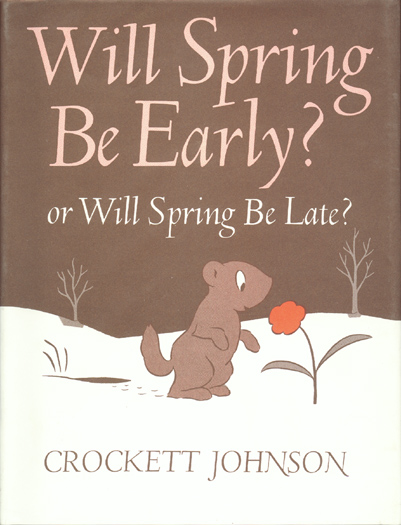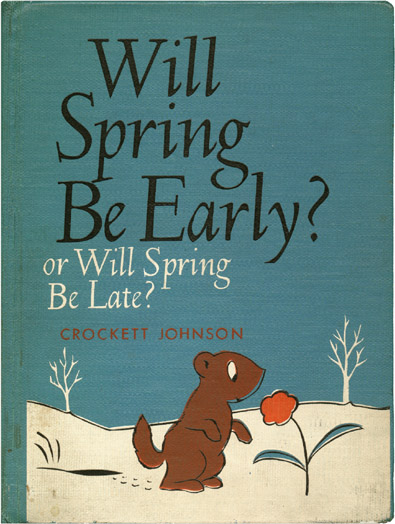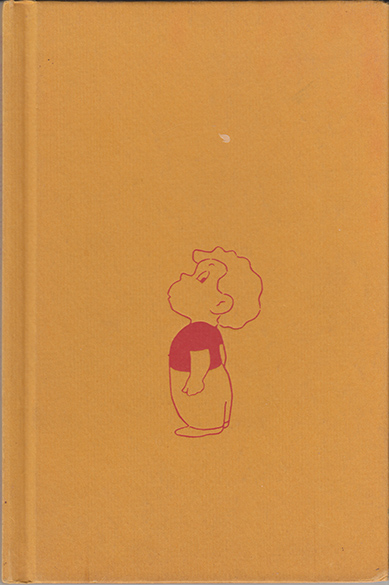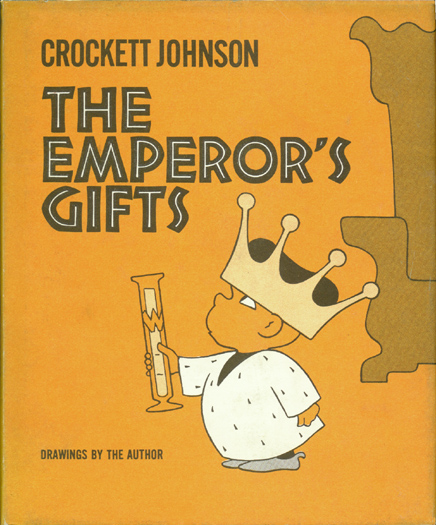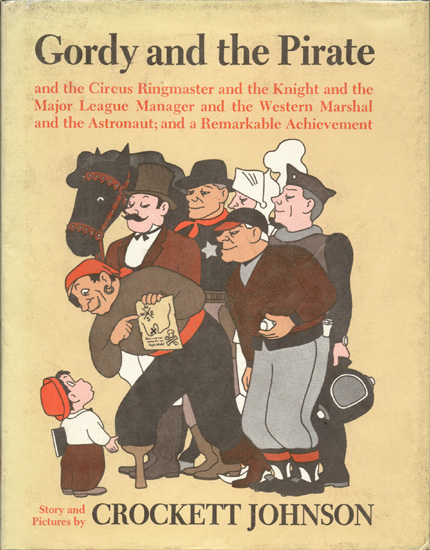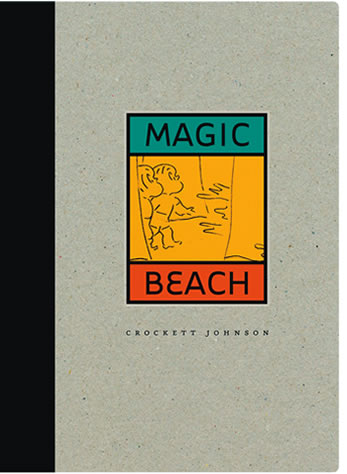Crockett Johnson’s Books: Others from the 1950s, 1960s, and 2005
Though the Harold series and the Barnaby comics are Johnson’s best-remembered books, he wrote and illustrated many others. Here are the others he both wrote and illustrated.
Others from the 1950s
Who’s Upside Down? (1952)
A kangaroo who had been feeling “on top of the world” happens upon a geography book and, seeing herself “down underneath” the globe and “upside down,” she becomes upset. Although she thinks herself and “everything around here” is upside down, her little kangaroo wonders if it isn’t the geography book that’s really upside down.
Terrible, Terrifying Toby (1957)
A puppy named Toby encounters many “terrible and terrifying” things — such as a squirrel, frog, and butterfly. He discovers that, if he growls at them, they leave, which in turn makes him feel more “terrible and terrifying” than they (and, of course, very proud of himself).
Time for Spring (1957)
Irene is ready for winter to end, but her snowman is not. She is tired of winter games, while he would be happy playing them well into July (all the more time to “practice,” as he points out). Furthermore, he insists that spring will not come as long as he’s here. Will winter never be over?
The Blue Ribbon Puppies (1958)
A little boy and a little girl decide to award a blue ribbon to the best of their seven pups. However, they find that each pup — whether fat, spotty, long, tall, small, shaggy, or plain — is quite remarkable in his own way. Let’s hope they have enough blue ribbon!
Merry Go Round (1958)
This 12-page book is a ride that doesn’t end. Spiral-bound so that the reader can keep turning the pages, Merry Go Round’s last page — “ON HE RODE, PAST THE YELLOW SIGN, AND ON” — leads directly to the first page. And the first page also happens to be the book’s cover, which has the words “AND ROUND AND ROUND AND ROUND AND ROUND” where Johnson’s name should be. So, as the scene changes behind him, the story keeps the merry go round turning.
The Frowning Prince (1959)
When a king begins reading a story about a princess with “an irresistible smile,” his son (the prince) proclaims, “Nobody could make me smile.” While the prince insists that his frown is “immovable,” his father strives to refute him, calling in jesters, jugglers, and even the grand wizard. Playfully told, the narrative pokes fun at its “fairy tale” status: when the wizard suggests summoning the princess from the book, the king tells him not to bother because the “book said the princess lived once upon a time.” The wizard reminds him, “This is once upon a time.”
Will Spring Be Early? or Will Spring Be Late? (1959)
It’s the second of February and time for the Groundhog to make his prediction. On his way to tell the Badger, Doormouse, Rabbit, Skunk, Chipmunk, Squirrel, Raccoon, Bear, and Pig, he sees a flower sprouting from the snow. Not realizing that it had just fallen from the Artificial Flower Company’s truck, he rushes off to announce that spring is here already.
Others from the 1960s
We Wonder What Will Walter Be? When He Grows Up (1964)
“Walter wished somebody could decide for him. He was trying to think what to be when he grew up.” He asks a Lion, who summons the members of his council — the “best thinkers in the kingdom,” the Lion says. Antelope, Mole, Flamingo, Giraffe, Elephant, and Turtle convene to ponder Walter’s question. How will they answer?
The Emperor’s Gifts (1965)
Like We Wonder What Will Walter Be?, this story has the feel of a fable. The young emperor is to receive gifts from the rulers of his six kingdoms and “ponder[s] what to give them in return.” King Drowse the Lazy bears a bottle of Contentment; King Wot the Learned, a “tall crystal phial” of Wisdom; King Rash the Foolhardy, a beaker of Bravery; King Daunt the Scary, a “slim bottle” of Prudence; King Squander the Lavish, a “large jug” of Generosity; and King Grab the Greedy, a “glass flagon” of Ambition. An astute judge of each visitor’s personal strengths and weaknesses, the emperor works to match each gift with the king who needs it most.
Harper’s children’s books’ editor Ursula Nordstrom rejected this book: “I was slightly baffled as to what age child it would really interest — as the type of format would appeal to a younger child than could possibly enjoy the ideas,” she wrote Johnson in March 1964. But the editors at Holt, Rinehart and Winston liked it, publishing The Emperor’s Gifts in 1965.
Gordy and the Pirate and the Circus Ringmaster and the Knight and the Major League Manager and the Western Marshal and the Astronaut; and a Remarkable Achievement (1965)
The story begins, “The path from school ran close to a juniper hedge at the side of a duck pond. Behind the hedge, a step away from the bank, a small patch of bare earth stuck up out of the water the way a desert island rises in the ocean.” With more text and fewer illustrations than any of Johnson’s books, this one tells of Gordy’s struggle to fulfill his promise to “come straight home from school today.” But, at each step of the way, he’s invited to join in a potential adventure.
Magic Beach (2005). With an Appreciation by Maurice Sendak and an Afterword by Philip Nel.
Castles in the Sand (1965), published for the first time with Crockett Johnson’s original illustrations and original title.

